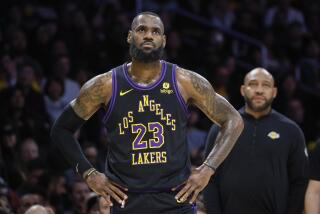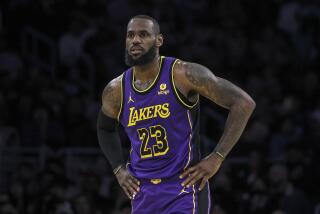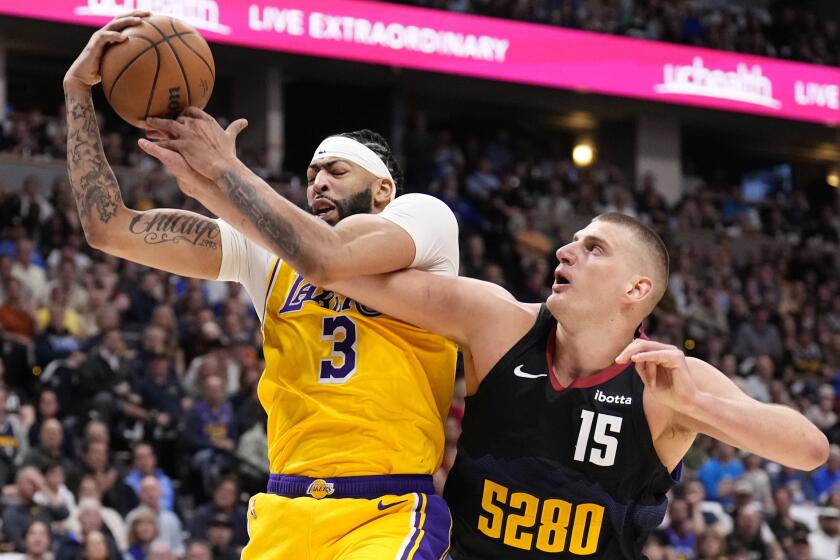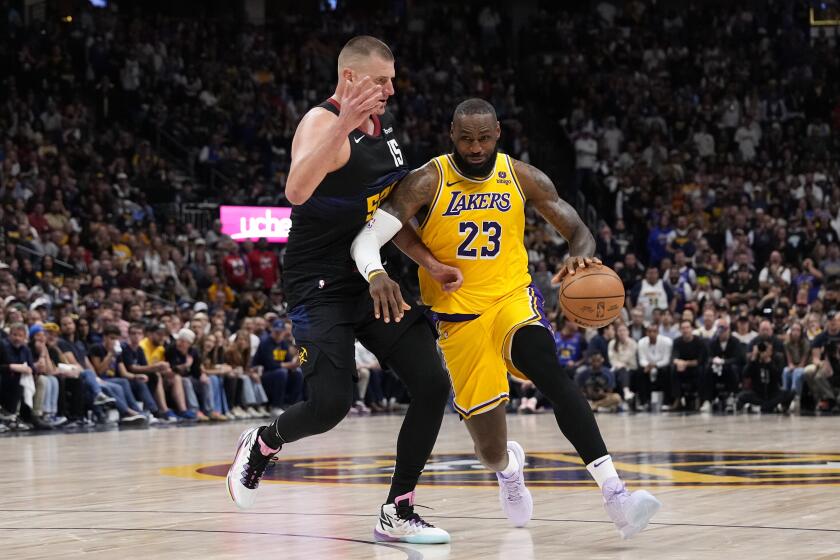Unable to rebuild with Chris Paul, the Lakers crumbled
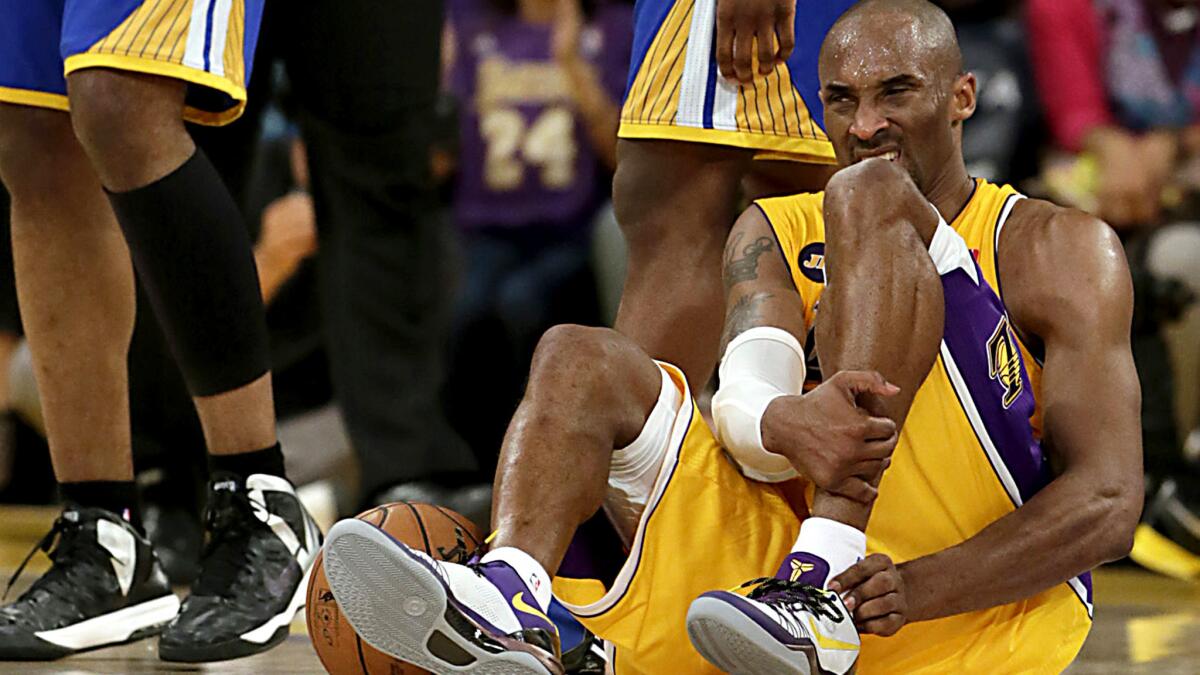
As Kobe Bryant aged, the number of debilitating injuries he sustained also increased.
“Basketball reasons.”
Few other phrases irk Lakers fans like that one.
“Paul Pierce wheelchair” might come close, along with “Deee-troit basss-ket-balll” and, for the slightly older generation, “sweltering Boston Garden.”
But the two words uttered by then NBA Commissioner David Stern, through a league spokesman, bother Lakers followers more than any in these free-fallin’ days of history-making.
They were the reason supplied for vetoing the Lakers’ trade for All-Star point guard Chris Paul in December 2011, the one that sent Lamar Odom into a tailspin, Pau Gasol into continual glance-over-shoulder mode and the franchise into a slow, steady, shocking decline.
------------
FOR THE RECORD:
Lakers timeline: In the Feb. 28 Sports section, a chart listing key dates in the Lakers’ recent history said Kobe Bryant fractured a bone in his knee in December 2014. It was December 2013. The chart also stated that All-Star LaMarcus Aldridge bypassed the Lakers to sign with San Antonio in July 2014; Aldridge signed with San Antonio in July 2015. —
------------
How did this happen, the Lakers as league laughingstocks next to the Philadelphia 76ers? First, a quick trip to happier times.
::
If ever there was a picture suitable for framing, a pose ready-made for bronzing outside Staples Center, it was Kobe Bryant after the Lakers won the 2010 NBA Finals.
He hopped onto the scorer’s table amid a purple-and-gold confetti storm, cradled the basketball in his left arm and screamed uncontrollably for several euphoric seconds.
The Lakers had just beaten the hated Boston Celtics in Game 7 at Staples Center, moving within one championship of the 17 already claimed by the Celtics. On a more individual note — and a personal one too, because everything was personal for Bryant back then — he moved within one championship of the six owned by Michael Jordan.
What wasn’t to like about the Lakers? They were back-to-back NBA champions with the best coach of all time, Phil Jackson. Bryant was a still-spry 31 years old and Gasol seemingly had plenty of miles to spare on his odometer. Odom was a smooth and versatile sixth man, Metta World Peace a top defender and young Andrew Bynum a shot-blocking, rebounding force when healthy.
Slowly and sadly for one of L.A.’s sports treasures, the corrosion began to appear not long after the trophy was handed out and champagne sprayed on that June night.
Jackson was soon diagnosed with treatable but energy-sapping cancer and had only one season left in him as a coach. The 2010-11 Lakers campaign was marked by an embarrassing second-round playoff sweep by the Dallas Mavericks, symbolized by Bynum body-slamming diminutive guard J.J. Barea and stalking off the court bare-chested after getting ejected in the final game.
There were signs of Bryant’s body starting to wear down during that series, and in the off-season he went to Germany for an innovative knee procedure. It represented a tear in Superman’s cape even though it led to another two years of top-flight basketball for Bryant.
Then the Paul trade arrived.
The 2011-12 season was delayed because of a labor lockout that lifted just in time for a slate of Christmas Day openers.
Sensing a need to restock the roster and capitalize on Bryant’s last good years, the Lakers acquired Paul from New Orleans for Odom and Gasol.
Only they didn’t.
The three-team trade was nixed because of “basketball reasons” by Stern, who acted on behalf of a New Orleans franchise that had been purchased temporarily by the NBA when its owner fell into financial hardship.
No one seemed more surprised by Stern’s rejection of the deal than Paul, who simply wrote “WoW” on Twitter that day.
The Lakers would have shifted overnight from finesse, precision and depth in the frontcourt to speed and athleticism in the backcourt.
They tried to rebuild another way in July 2012, after a nondescript season came and went with another second-round playoff defeat. Two-time most valuable player Steve Nash was acquired for two first-round draft picks and two second-round picks in a deal that still haunts the Lakers. They traded for center Dwight Howard a month later, seemingly fit for the future and a bright 2012-13 season.
But Nash was injured in his second game, symbolic of his meager contributions during a three-year, $28-million contract. The lighthearted Howard never came close to jelling with the ever-demanding Bryant.
As the Lakers languished in the standings, devastating news came from Cedars-Sinai Medical Center on February 18, 2013. Lakers owner Jerry Buss died at 80 of kidney failure after a bout with an undisclosed form of cancer, leaving the Lakers without their patriarch.

Much like when the Lakers brought in aging veterans Gary Payton and Karl Malone, things didn’t work out well with (above, left and right) Dwight Howard and Steve Nash.
As six of Buss’ adult offspring dealt with the loss of their father and the monumental task of inheriting the team, Bryant sustained a torn Achilles’ tendon in April. Not long after that, the Lakers were swept meekly by San Antonio in the first round of the playoffs.
The summer of 2013 was a harbinger of bad times to come.
Howard bolted quickly for Houston as a free agent and Gasol, after facing trade rumors for years and at last a free agent himself, headed for a more promising basketball climate in Chicago. Both players took less money to leave the Lakers, who also failed to land big-name free agents in subsequent summers. Carmelo Anthony, LeBron James, LaMarcus Aldridge, Greg Monroe and DeAndre Jordan were all courted without success.
The lone high-profile player the Lakers managed to sign was one of their own. It was a crippling contract.
Before Bryant fully returned from his Achilles injury, the Lakers gave him a two-year, $48.5-million extension in November 2013 that hamstrung their salary cap as he descended into the injury-prone twilight of his career.
Off the court, there were questions about the Lakers’ ability to hire a winning coach after Jackson left the sidelines. Mike Brown lasted slightly more than one season, Mike D’Antoni made it through two and Byron Scott is 32-110 in two seasons.
After seasons of 27-55 and 21-61, the Lakers are 11-49, better than only the 76ers, and will miss the playoffs a third consecutive time. This has never happened since the franchise began play in 1948.
Nobody could envision it back in the confetti-filled days of 2010. Nobody.
Follow Mike Bresnahan on Twitter: @Mike_Bresnahan
More to Read
All things Lakers, all the time.
Get all the Lakers news you need in Dan Woike's weekly newsletter.
You may occasionally receive promotional content from the Los Angeles Times.
